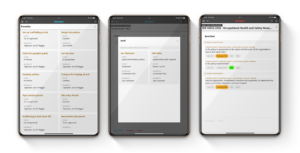Three Threats to Safety Leaders + Your Ultimate Defense
Previously in our EHSQ Leadership 101 series, we touched on Dominic Cooper’s claim that known hazards pose the greatest risk to workplace safety as workers struggle to believe management is sincere about safety and withdraw from the process.1
The “last mile problem”—the frustrating gap between recognizing dangers and actually doing something about them—is notorious. Whether it’s a shortage of time, resources, or just a case of procrastination, it presents a real problem.
But it’s not the only challenge keeping safety leaders on their toes. They face challenges from three fronts: pressures from upper management, resistance from shop floor workers, and traits from within themselves.
Make yourself heard
Ensuring safety doesn’t take a backseat to profit margins is a perennial challenge. Productivity and profitability take precedence, so convincing senior management to prioritize safety is no easy task. Especially given the budgetary demands and organizational goals they need to juggle.
To sway senior management, you need to demonstrate the intrinsic value of safety as a business priority. Presenting compelling data that showcases the long-term benefits of investing in safety initiatives can help the message hit home.
Effective communication is key to promoting safety in your workplace. Yet all too often there’s confusion about existing safety management systems and associated policies. Add language differences and ineffective communication channels into the mix and you hinder the sharing of critical safety information.
Be sure to set up open and transparent communication channels so that safety messages reach everyone in your organization. When you bring in tools and technology like EHSQ software, it’s also important to train everyone effectively and establish best practices. This will help you get the most out of these tools when it comes to driving safety outcomes.
Winning hearts and minds
When translating safety leadership to the shop floor, you’ll likely face three main challenges: complacency, resistance to change, and lack of engagement.
Familiarity breeds complacency: over time, workers may overlook potential hazards or risks in routine tasks. You’ll need to stay vigilant about risks and continuously reinforce safety protocols.
Introducing new safety initiatives might meet resistance from those comfortable with the status quo. Here, good communication is essential. When implementing changes, be ready to explain why these changes are necessary and address any concerns to secure buy-in from your workers.
Successfully engaging employees in safety initiatives is key, but building a safety culture involves more than issuing top-down directives. It requires active participation and a shared sense of responsibility from everyone.
Practice what you preach
There’s no room for finger-pointing or the blame game when it comes to safety leadership. Success thrives on accountability, and one of the biggest challenges you’ll face is yourself.
You’ll need unwavering commitment to consistently uphold safety standards and procedures across the organization. There’s no room for double standards or a “do as I say, not as I do” mindset. Leading by example means you need to practice what you preach. So, next time you schedule a training session for your team, make sure you mark it in your calendar and actively participate.
Building your safety leadership toolbox

Overcoming these challenges is crucial to safety and operational success.
Luckily, there’s a tried and tested approach that effective safety leaders employ to tackle these issues: they ask why certain problems continue, take action to fix them, keep everyone updated on solutions, track progress, and check if the fixes work.
Even better, EHSQ software gives you the framework to conduct this process methodically, helping you lead your safety program effectively and efficiently.
- Create a seamless process that integrates incident management with corrective and preventive actions. Quickly identify, assess, and tackle risks to keep your workplace safe from potential hazards.
- Streamline safety efforts by consolidating data from various sources into a centralized platform. Anticipate risks and make proactive decisions based on comprehensive insights.
- Win over senior leaders by demonstrating the value of safety initiatives. Build customizable dashboards and reports to demonstrate that safety is a priority.
- Foster open communication and boost employee engagement with automated notifications and real-time updates that keep everyone in the loop about safety initiatives.
- Clearly define safety protocols and conduct regular audits to ensure they are consistently implemented. Automate refresher training to combat complacency and keep safe procedures top of mind.
- Assign tasks, track their completion status, and set deadlines, ensuring accountability, timely resolution of safety issues, and overall efficiency.
- Provide access to safety information and tools anytime, anywhere, enabling field workers to report incidents, access safety procedures, and stay updated on safety initiatives.
- Use data to identify trends, anticipate risks, and make informed decisions for continuous improvement in safety performance.
From combating complacency to securing support from senior management, you must overcome challenges from three fronts to excel in safety leadership. With effective strategies at your side and EHSQ software at your fingertips, you can methodically overcome these barriers to drive impactful safety initiatives.
Ready to level up your safety leadership? Book a demo today and we’ll show you how TenForce can help.
Sign Up for email updates about our latest projects, articles and online events.

[1] Dominic Cooper, Effective Safety Leadership: Understanding Types and Styles that Improve Safety Performance
